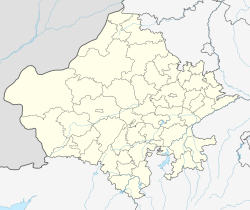This article needs additional citations for verification. (November 2024) |
Bidasar | |
|---|---|
| Coordinates: 27°50′N 74°18′E / 27.83°N 74.3°E | |
| Country | |
| State | Rajasthan |
| District | Churu |
| Government | |
| • Type | self |
| Elevation | 304 m (997 ft) |
| Population (2019) | |
• Total | 100,000+ |
| Languages | |
| • Official | Hindi Bagri |
| Time zone | UTC+5:30 (IST) |
| PIN | 331501 |
Bidasar is a city and a municipality in Churu district in the state of Rajasthan, India. derives its name from the Bidawat Rathores, descendants of Rao Bida, a son of Rao Jodha of Marwar and brother of Rao Bika, the founder of Bikaner. The region’s history is intricately tied to the Rathore clan’s expansion and their conquest of territories in northern Rajasthan.
Before the arrival of the Rathores, the area encompassing Bidasar, known as part of the Bidawati region, was under the control of the Mohil (or Mohal) Rajputs. The Mohils held a small district with their capital at Chhapar, near Bidasar. This region was part of the broader Jangladesh area, inhabited by various Rajput clans, including the Mohils, as well as Bhati, Bhatti, and Johiya groups. The Mohil Rajputs were a significant local power, controlling key territories in what is now Churu district.
In 1465, Rao Bida, accompanied by his brother Rao Bika and their uncle Rawat Kandhal, embarked on a campaign to conquer territories in Jangladesh, as encouraged by their father, Rao Jodha of Marwar. Rao Bida, leading a force of approximately 3,000 horsemen, played a pivotal role in displacing the Mohil Rajputs from their stronghold in the Bidawati region, including Bidasar. The conquest was part of a broader effort to establish Rathore dominance in the region, with Rao Bika founding the principality of Bikaner in 1488. Specifically, Rao Bika captured Chhapar and Dronapur for his brother Rao Bida, establishing the foundation for the Bidawat Rathore sub-clan. The defeat of the Mohil Rajputs by Rao Bida and his allies marked a turning point, as the region was brought under Rathore control and renamed Bidasar after Rao Bida.
Following the conquest, Rao Bida’s descendants, known as the Bidawats, established Bidasar as a thikana (feudal estate) under the Bikaner State. The estate initially comprised 12 villages and was governed by the Keshodasot family of the Bidawat clan. Thakur Kesho Das, a great-grandson of Rao Bida, was granted the estate of Bidasar around 1609, marking the formal establishment of the thikana. He initiated construction projects in the area, solidifying its importance. The thikana was later ruled by a series of Thakurs, including Achal Das (1625–1635), Man Singh (1635–1641), and subsequent rulers, who maintained the estate’s prominence within Bikaner State. By 1682, the estate had expanded to include 15 villages under Thakur Daulat Singh
Geography
[edit]Bidasar- is located at 27°50′N 74°18′E / 27.83°N 74.3°E.[1] It has an average elevation of 304 metres (997 feet). The area is also very sandy and extremely rocky.[citation needed]
Demographics
[edit]As of 2001[update] India census,[2] Bidasar had a population of 30,103. Males constitute 52% of the population and females 48%. Bidasar has an average literacy rate of 45%, lower than the national average of 59.5%; with male literacy of 56% and female literacy of 34%. 19% of the population is under 6 years of age.
References
[edit]- ^ Falling Rain Genomics, Inc – Bidasar
- ^ "Census of India 2001: Data from the 2001 Census, including cities, villages and towns (Provisional)". Registrar General and Census Commissioner of India. Archived from the original on 16 June 2004. Retrieved 1 November 2008.

